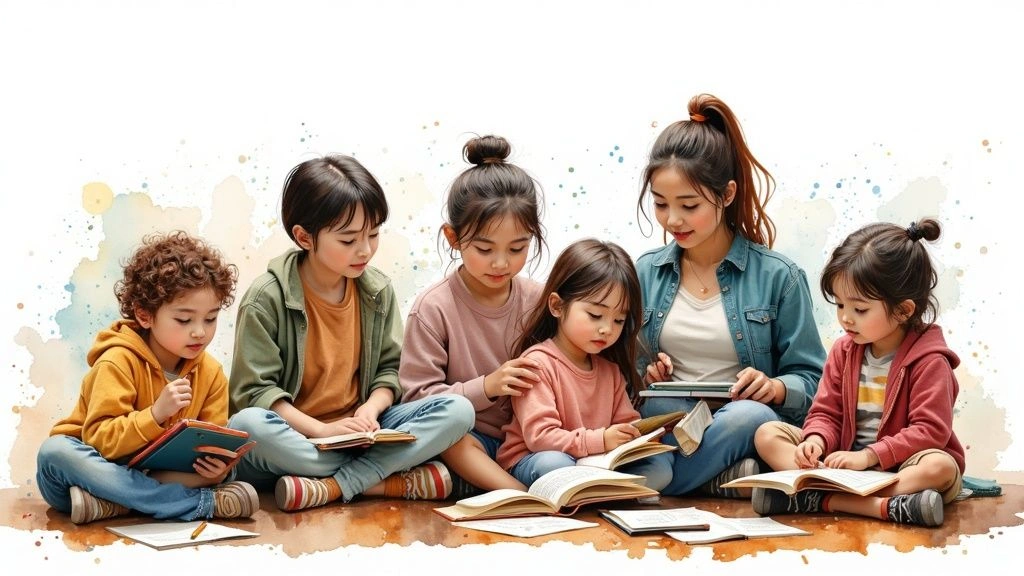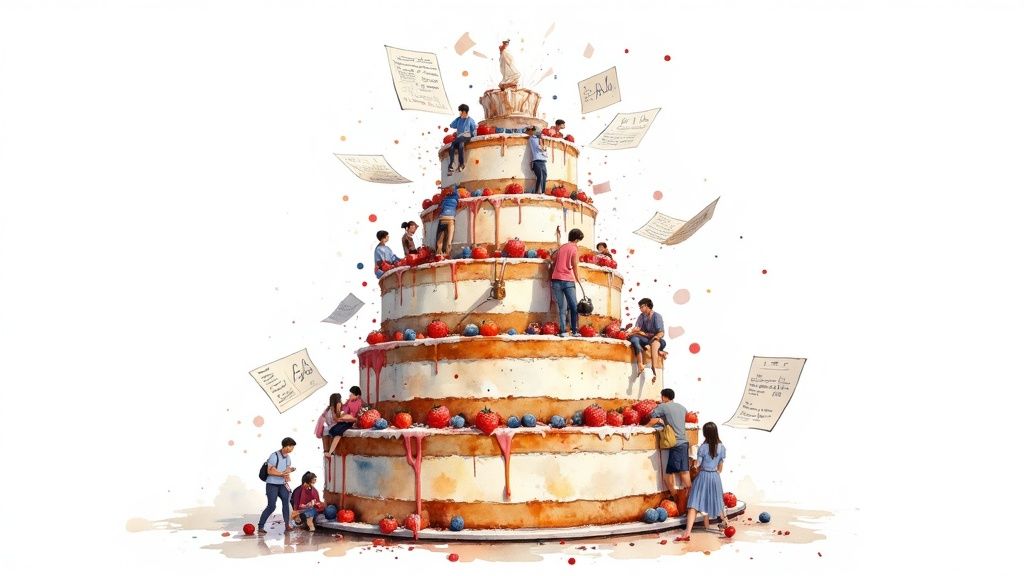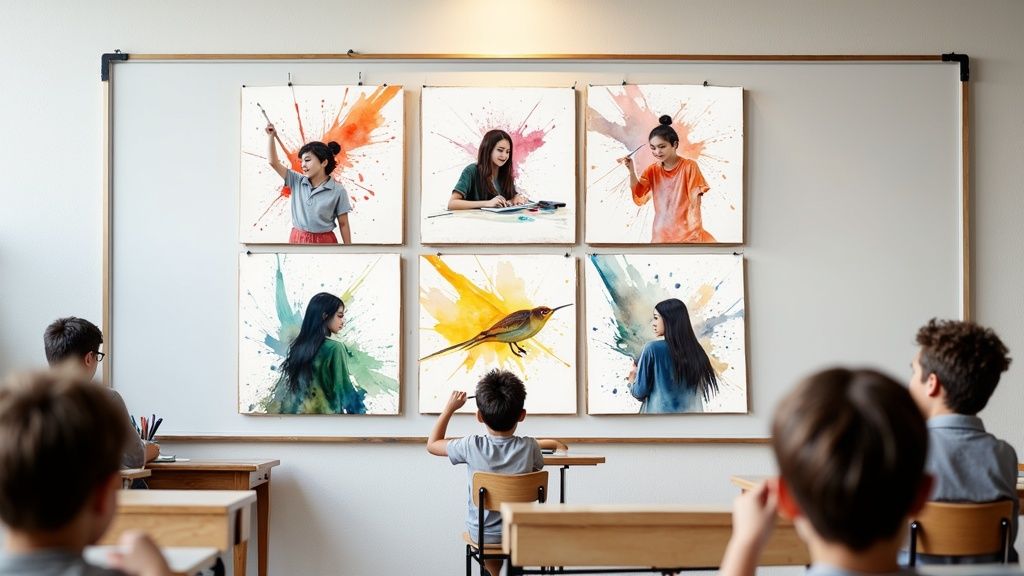10 Differentiated Instruction Examples: Empowering Diverse Learners
February 18, 2025

Unlocking Student Potential: A Guide to Differentiated Instruction
Do your students seem disconnected during lessons? Have you noticed that your teaching methods work great for some learners but completely miss the mark for others? Most educators face this challenge. The reality is that every student processes and absorbs information differently. That's why differentiated instruction has become such a powerful teaching approach.
Gone are the days of treating every student the same way. Modern education recognizes that students have unique learning styles, interests, and readiness levels. By adapting teaching methods to match individual needs, educators can help each student reach their full potential.
The shift away from one-size-fits-all teaching has strong roots in educational research. Experts like Carol Ann Tomlinson drew from theories like Vygotsky's Zone of Proximal Development and Gardner's Multiple Intelligences to develop practical differentiated instruction methods. The results? Students show higher engagement, better comprehension, and stronger academic performance when lessons are tailored to their individual needs.
Key elements that make differentiated instruction work include:
- Flexible learning environments
- Activities matched to student skill levels
- Multiple options for demonstrating knowledge
- Regular assessment to track progress
- Adjustments based on student feedback
This guide will give you practical examples and strategies to implement differentiated instruction effectively - whether you're teaching in a classroom, working one-on-one, or supporting learning at home. Let's explore how to help every student succeed by meeting them where they are.
1. Tiered Assignments
Every student deserves to feel challenged and supported in the classroom. This is where tiered assignments shine - they let teachers adapt activities for different skill levels while keeping everyone focused on the same core concepts. It's a practical approach that helps each student grow and succeed at their own pace.

Think of it like a mountain hike - all students aim to reach the summit (learning goal), but some take an easier path while others tackle a steeper route. The key is that everyone gets where they need to go.
How does it work in practice?
Take a lesson on fractions: Beginning students might color pre-divided shapes, intermediate students solve word problems, and advanced students scale recipes using fractions. The lesson builds from basic understanding to real-world application, following Bloom's Taxonomy principles of learning.
Key Features and Benefits:
- Same Goals, Different Paths: All students work toward identical learning objectives through appropriately challenging tasks
- Perfect Challenge Level: Work matches student readiness to prevent boredom or frustration
- Better Focus: Students stay more engaged when tasks match their abilities
Pros and Cons:
Pros:
- Meets diverse learning needs
- Improves student engagement
- Builds student confidence
- Provides appropriate challenges
Cons:
- Takes extra prep time
- Needs more materials
- Requires careful group management
Tips for Implementation:
- Start Simple: Begin with just 2-3 tiers
- Use Colors: Organize materials by color-coding
- Keep Core Ideas Clear: Main concepts stay the same across all levels
- Check Progress: Regularly review and adjust student placement
A Little History:
Carol Ann Tomlinson, a leader in education, helped spread tiered assignments through her work on differentiated instruction. Her practical methods have helped teachers create more effective learning environments.
Tiered assignments work because they respect how each student learns differently. When we give students work at the right level, we help them build confidence and master new skills at their own pace.
2. Learning Stations/Centers

Learning stations bring education to life by creating distinct activity zones within the classroom. Picture a space where students move between different areas - each dedicated to a specific subject or skill. One station might focus on math practice, another on silent reading, and others on science experiments or writing projects. This setup helps students learn in ways that work best for them.
The classroom comes alive with purposeful activity. You might see a group absorbed in books at the reading corner, while others work on math games at computer stations. Some students could be building models with hands-on materials, as the teacher provides focused instruction to a small group. Each station serves a clear learning purpose.
Key Benefits of Learning Stations:
- Students Take Charge: Kids become more independent by choosing activities and working at their own speed
- Group Flexibility: Stations work for both solo and team learning
- Different Learning Styles: Whether through reading, listening, doing, or watching - stations meet varied student needs
- Personal Attention: Teachers can give focused help to small groups
Common Challenges to Consider:
- Room Layout: You need adequate space to set up effective stations
- Preparation: Creating engaging station activities requires careful planning
- Student Management: Good organization skills help minimize disruptions
- Sound Level: Multiple activities can increase classroom noise
Tips for Success:
- Clear Rules: Set specific routines for moving between stations - timers help!
- Self-Checking: Let students track their own progress when possible
- Simple Directions: Post clear, visual instructions at each station
Real Example: In a fourth-grade math class, stations include flashcard practice for multiplication, fraction building with manipulatives, and real-world problem-solving using store flyers. Meanwhile, the teacher works directly with students who need extra help with division.
Learning stations are so valuable because they let teachers meet individual student needs while keeping the whole class actively engaged. With thoughtful planning, these dynamic spaces help students grow and succeed.
3. Flexible Grouping
Flexible grouping is a teaching approach where students are organized into different groups that change based on learning goals, student needs, and ongoing assessments. Instead of keeping students in fixed groups that can lead to labels like "the advanced group," flexible grouping allows teachers to adjust and remix groups to support each student's learning journey.
The magic of flexible grouping comes from its adaptability - groups can shift daily, weekly, or even within a single lesson. This helps prevent students from feeling stuck in one level and lets teachers respond quickly to how students are progressing.
Key elements that make flexible grouping work:
- Assessment-based decisions: Teachers use both formal and informal assessments to understand where students are and form groups accordingly
- Multiple ways to group: Students might be grouped by skill level for math practice, shared interests for book discussions, or mixed abilities for collaborative projects
- Balance of similar and mixed skill levels: Some activities work best with students at similar levels, while others benefit from bringing together different skill levels for peer learning
Examples in action:
- Book clubs where students choose books based on their interests
- Small math groups working on specific skills together
- Project teams with diverse abilities collaborating
- Buddy pairs where one student helps teach another
Benefits:
- Avoids permanent labels and encourages growth mindset
- Provides targeted support based on individual needs
- Helps students develop social skills with different peers
- Creates opportunities for students to learn from each other
Challenges:
- Regular assessment needed to inform grouping
- Complex to manage multiple groups at once
- Need clear systems for group transitions
Tips for success:
- Use data to guide group assignments
- Be willing to change groups frequently
- Document your grouping decisions and reasoning
- Create smooth procedures for switching activities
Student engagement is key to making flexible groups work. For more ideas on boosting participation and creating an active classroom, check out: Classroom Engagement Strategies. When implemented thoughtfully, flexible grouping helps create a classroom where every student can thrive.
4. Choice Boards
Choice boards are powerful learning tools that give students options to explore topics in their own way. They work like a menu of activities, displayed in a visually appealing grid or layout, where students can select how they want to learn or demonstrate their knowledge.

These boards shine by offering diverse learning paths. A student studying the American Revolution could choose to write a colonist's newspaper article, build a battle scene diorama, or compose a song about key events. This variety ensures every student can engage with content in ways that match their natural strengths and interests.
When students get to pick activities aligned with their preferences, they become more invested in their learning. For example, an artistically-minded student might better grasp scientific concepts by creating a comic strip explanation rather than writing a traditional report.
Education expert Kathie F. Nunley helped popularize choice boards as an effective tool for differentiated instruction. The approach puts students at the center of their learning journey, acknowledging that each child learns differently.
Pros:
- Boosts engagement through meaningful choices
- Develops decision-making as students evaluate options
- Fits different learning styles and student interests
- Encourages independence in the learning process
Cons:
- Some students need help selecting appropriate options
- Students may stick to familiar choices rather than trying new approaches
- Creating multiple activity options takes extra planning time
Common Formats:
- Tic-Tac-Toe style boards
- Learning Menus
- Think-Tac-Toe grids
- Choice matrices
Implementation Tips:
- Write clear directions for each activity
- Mix easy and challenging options
- Set specific completion deadlines
- Include grading rubrics for each choice
Choice boards effectively transform passive learning into active exploration. By giving students control over how they learn, these tools create more engaging and personal educational experiences. For more creative learning ideas, check out Creative Expression Activities, which pair well with choice boards - especially for visually-oriented learners.
5. Project-Based Learning with Differentiated Outcomes
Project-Based Learning (PBL) with differentiated outcomes helps students learn in ways that match their unique abilities and interests. Rather than everyone doing identical assignments, students explore topics through hands-on projects that can take different forms to show understanding. It's like giving students a choice of paths to reach the same destination.
More teachers are using this method because they see how well it works for different types of learners. Standard assignments often leave some students bored or struggling, but PBL lets each student work at their own pace and excel in their own way.
How does it work in practice?
Consider a class studying environmental science. Instead of just reading textbooks, students might choose different project formats:
- Budding scientist? Conduct a scientific investigation into local water quality.
- Aspiring journalist? Write an investigative report on the impact of plastic pollution.
- Creative artist? Design a public awareness campaign advocating for sustainable practices.
- Tech whiz? Develop an app that helps people track their carbon footprint.
The beauty is that everyone learns the core concepts while expressing their understanding in personally meaningful ways.
Key elements for success:
- Open-ended projects: Students have freedom to explore and take ownership of their learning
- Multiple entry points: Different approaches based on interests and knowledge
- Various presentation options: Written reports, videos, presentations - whatever fits best
- Real-world connections: Projects tackle actual issues students care about
Benefits:
- Engages multiple intelligences: Works for visual, auditory, and hands-on learners
- Develops deeper thinking: Builds critical thinking and problem-solving skills
- Allows creative expression: Students showcase their unique talents
- Better assessment: Shows understanding more completely than tests alone
Challenges to consider:
- Takes more time: Projects often need more class time than traditional lessons
- Resource needs: Some projects require special materials or technology
- Complex grading: Evaluating different types of projects needs careful planning
- Structure matters: Some students need more guidance with open-ended work
Tips for teachers:
- Clear guidelines: Share learning goals and expectations while allowing choice
- Step-by-step support: Break down big projects into smaller pieces
- Regular check-ins: Monitor progress and give feedback throughout
- Detailed rubrics: Define success criteria clearly from the start
Why this approach works: PBL with differentiated outcomes acknowledges that students learn differently. It gives them control over their learning while building important skills for their future. This method especially helps students who thrive with hands-on, personalized learning experiences.
6. Compacting Curriculum
Compacting curriculum is a proven teaching approach that lets students learn at their own pace. It starts by identifying what students already understand and then adjusts their learning path accordingly - allowing them to skip material they've mastered and move on to new challenges that match their abilities.
The Process Works in Three Key Steps:
-
Initial Assessment: Start by evaluating what students already know through methods like quizzes, discussions, portfolio reviews, or classroom observation. This helps identify their current mastery level.
-
Adjusting the Plan: Based on assessment results, modify the standard curriculum. For example, if a student shows strong understanding of basic fractions, they can skip the review and jump into working with decimals or percentages.
-
Advanced Learning: Use the time saved to provide enriching activities that challenge students further - whether that's exploring topics in greater depth, connecting different subjects, or studying advanced material.
Examples in Action:
-
Math: A fifth grader who has already mastered fourth-grade concepts can skip review units and start exploring algebra, supported by challenging problem-solving activities.
-
Reading: A student reading above grade level could choose more advanced books, join literature discussions with older students, or start creative writing projects.
Why This Approach Works: Compacting helps meet the needs of advanced learners who might otherwise feel held back. It keeps them engaged and helps them develop their full abilities.
Benefits:
- Keeps students interested and challenged
- Makes better use of learning time
- Allows faster advancement
- Meets individual student needs
Challenges:
- Requires careful student assessment
- Takes extra effort to manage in larger classes
- Needs thoughtful scheduling
Tips for Success:
- Keep Records: Track assessment results and learning plans to monitor progress effectively
- Check Progress: Regularly evaluate how students are doing and adjust plans as needed
- Update Parents: Keep families informed about their child's learning path and activities
- Plan Good Activities: Create engaging advanced work that truly challenges students
Background Note: Educational researcher Joseph Renzulli helped develop this approach through his work on supporting gifted students. His focus was on recognizing and developing each student's unique talents.
Curriculum compacting helps create learning experiences that match each student's abilities and interests. When done well, it helps students stay motivated and reach higher levels of achievement.
7. Think-Pair-Share with Differentiated Questions
Think-Pair-Share is a common teaching approach that gets a major upgrade when you add personalized questions for different student levels. This enhanced version ensures every student feels both supported and challenged in their learning journey.
The basic flow remains familiar - students first think independently about a question, pair up to discuss their ideas, then share insights with the whole class. The key improvement comes from providing questions at different difficulty levels matched to student abilities.
Key elements that make this approach effective:
- Individual reflection time: Students develop their own thoughts before hearing from peers
- Partner discussions: Creates a comfortable space to test ideas and practice communication
- Class sharing: Students learn from hearing multiple perspectives
- Leveled questions: Questions tailored to different abilities keep all students engaged
Examples across subjects:
- Literature: Basic level - "Describe the community in The Giver" vs Advanced level - "Analyze how sameness affects individual identity"
- Math: Some students solve a straightforward equation while others explore real-world applications
- Science: Basic level students label water cycle stages while advanced students design evaporation experiments
- History: Timeline creation vs primary source document analysis of the American Revolution
What makes it successful: The traditional Think-Pair-Share format sometimes leaves students either struggling or bored. This adapted version acknowledges different learning levels while keeping the proven benefits of the original approach.
Tips for classroom use:
- Create question sets: Design questions at multiple difficulty levels using Bloom's Taxonomy
- Plan student pairs: Sometimes match similar abilities, other times mix levels based on your goals
- Keep it moving: Set clear timeframes for each phase
- Guide discussions: Listen in and offer support or extension questions as needed
Benefits:
- Meets diverse learning needs
- Gets everyone involved
- Develops speaking skills
- Simple to implement
Challenges:
- Can highlight student differences
- Timing takes practice
- Requires thoughtful partner matching
This enhanced Think-Pair-Share approach helps create an inclusive classroom where every student can meaningfully participate and grow. The differentiated questions allow you to challenge each learner appropriately while maintaining the collaborative benefits of the original strategy.
8. Anchor Activities: A Smart Solution for Early Finishers
Good classroom management means having a plan for students who finish their work early. This is where anchor activities come in - meaningful tasks students can work on independently when they complete assignments or during transition times. These activities help teachers effectively manage different learning speeds while keeping all students productively engaged.
An anchor activity is an ongoing, self-directed task tied to current learning objectives and offered at multiple difficulty levels. The goal is to keep all students challenged and learning, rather than sitting idle or causing disruptions after finishing their work.
The Rise of Anchor Activities
Teachers noticed that traditional classrooms often left quick finishers with nothing meaningful to do, leading to boredom and potential behavior issues. Anchor activities emerged as a practical solution that keeps early finishers engaged while reinforcing key concepts. They've become essential for creating adaptable learning environments.
Real Examples in Action
Here's how anchor activities work in practice. In a history class studying the American Revolution:
- Basic Level: Write a journal entry answering "If you were a colonist, would you support independence? Why?"
- Intermediate Level: Research and present a report on a key historical figure
- Advanced Level: Design an educational board game about revolutionary events
Math teachers might offer fraction practice ranging from simple coloring sheets to word problems using real-world scenarios.
Benefits and Challenges
Key Benefits:
- Keeps early finishers productively occupied
- Reinforces current learning objectives
- Builds student independence
- Reduces classroom disruptions
Main Challenges:
- Requires regular updates to keep activities fresh
- May need multiple sets of materials
- Some students might rush their regular work
Tips for Success
- Create clear guidelines for when and how to use anchor activities
- Update and rotate activities regularly to maintain interest
- Include self-checking components like answer keys
- Connect activities directly to current classroom topics
Why These Activities Matter
Anchor activities deserve attention because they solve a common teaching challenge in a positive way. Instead of letting early finishers sit idle, these activities turn extra time into valuable learning opportunities. When implemented thoughtfully, they help create an environment where every student stays engaged and challenged at their own pace.
9. RAFTs (Role, Audience, Format, Topic)
RAFTs is a writing approach that helps students demonstrate learning in engaging and meaningful ways. The acronym stands for Role, Audience, Format, and Topic - four key elements that guide students to write creatively while showing mastery of academic content. Rather than simply summarizing information, students take on different personas, write for specific audiences, use varied formats, and explore chosen topics.
For example, when studying the American Revolution, a student could write as King George III sending a letter to Parliament about colonial rebellion. Or they might become a colonial woman recording her thoughts about the Boston Tea Party in a diary. This approach brings historical events to life through personal perspectives.
Key Elements of RAFTs:
- Roles: Students can become historical figures, book characters, scientists, or other relevant personas
- Audiences: Writing changes based on who will read it - from personal letters to public speeches
- Formats: Students can use poems, news articles, journals, scripts and more
- Topics: Works across subjects from history to science to literature
Benefits for Learning:
RAFTs gives students choices in how they show understanding. Visual learners might create comics while auditory learners write songs. This flexibility helps engage different learning styles while building critical thinking as students analyze perspectives and adapt writing approaches.
Advantages:
- Sparks creativity: Makes learning active and imaginative
- Supports learning styles: Works for visual, auditory, and hands-on learners
- Builds writing skills: Practice writing for different purposes
- Gives student choice: Students take ownership of learning
Challenges:
- Needs clear modeling: Teachers must demonstrate the process well
- Some need structure: Too many choices can overwhelm some students
- Complex assessment: Creative work is harder to grade objectively
Real Examples:
- History: A Roman senator writes a speech about Julius Caesar
- Science: A water molecule keeps a diary about the water cycle
- Literature: A character writes a letter to another character
- Math: A fraction creates a rap about adding and subtracting
Tips for Teachers:
- Show examples: Share successful student work
- Create choice grids: Organize options for roles, audiences, formats and topics
- Break it down: Guide students through each step
- Use clear rubrics: Define expectations for assessment
Origins:
Doug Buehl helped popularize RAFTs as a way to make writing more engaging. The strategy remains effective because it combines creative expression with academic content, helping students develop both subject knowledge and communication abilities.
10. Multi-Level Technology Integration

Multi-level technology integration helps students learn in different ways based on their individual needs. It's about using digital tools to provide options for learning content, practicing skills, and demonstrating understanding. This empowers both teachers and students to create engaging learning experiences.
For example, in a typical classroom using this approach, one student might learn multiplication through an interactive game while another works through structured practice problems using an adaptive program. Tools like digital platforms, multimedia content, and interactive software make this possible. The flexibility benefits everyone from parents looking for enrichment activities to therapists incorporating art into their practice.
Picture a science class where some students explore concepts through virtual simulations while others dive into digital textbooks with embedded videos. This kind of setup allows each student to learn at their own pace and receive instant feedback. For teachers, tracking tools provide valuable data to monitor progress and adjust instruction as needed.
Several popular tools showcase this approach in action. Khan Academy and IXL create personalized math learning paths. Newsela offers news articles at different reading levels. PhET Interactive Simulations lets students explore science hands-on in a virtual space.
The SAMR Model by Dr. Ruben Puentedura has helped drive adoption of multi-level technology. This framework guides teachers in moving from basic tech substitution to creating entirely new types of learning activities. Learn more about how education is evolving in this space: Digital Transformation in Education.
Some challenges exist - ensuring equal access to devices and internet, providing tech support, and managing screen time effectively. Cost can also be an obstacle for some schools and families.
Key tips for successful implementation:
- Ensure equitable access: Make technology and internet available to all students
- Provide tech support: Train both students and teachers on using tools effectively
- Monitor progress: Use data tools to identify where students need help
- Balance screen time: Mix technology with other types of learning activities
Multi-level technology integration is more than just using devices - it's about creating personalized learning that works for each student. When implemented thoughtfully, it helps create engaging experiences that support real learning. Read more: How Technology is Personalizing Learning.
10-Point Differentiated Instruction Strategies Comparison
| Method | Difficulty | Time Required | Results | Best For | Key Benefit |
|---|---|---|---|---|---|
| Tiered Assignments | 🔄 Moderate | ⚡ High | 📊 High engagement | Diverse learners | ⭐ Meets varying needs |
| Learning Stations/Centers | 🔄 Moderate | ⚡ High | 📊 Promotes independence | Mixed-ability classrooms | ⭐ Facilitates flexible grouping |
| Flexible Grouping | 🔄 Moderate | ⚡ Moderate | 📊 Targeted instruction | Data-driven instruction | ⭐ Adaptive learning |
| Choice Boards | 🔄 Moderate | ⚡ Moderate | 📊 Increases engagement | Student-driven learning | ⭐ Enhances decision-making |
| Project-Based Learning with Differentiated Outcomes | 🔄 High | ⚡ Slow | 📊 Deep, authentic learning | Inquiry-based settings | ⭐ Develops critical thinking |
| Compacting Curriculum | 🔄 High | ⚡ Fast | 📊 Efficient advancement | Advanced learners | ⭐ Accelerates instruction |
| Think-Pair-Share with Differentiated Questions | 🔄 Low | ⚡ Fast | 📊 Inclusive discussion | Collaborative classrooms | ⭐ Encourages participation |
| Anchor Activities | 🔄 Low | ⚡ Fast | 📊 Productive use of time | Early finishers | ⭐ Reinforces learning |
| RAFTs (Role, Audience, Format, Topic) | 🔄 Moderate | ⚡ Moderate | 📊 Creative outputs | Writing-intensive settings | ⭐ Fosters creativity |
| Multi-Level Technology Integration | 🔄 High | ⚡ Moderate | 📊 Immediate, data-driven feedback | Tech-integrated environments | ⭐ Supports self-paced learning |
Differentiated Instruction: A Path to Inclusive Education
Teaching is all about recognizing that each student learns differently. I've found that approaches like tiered assignments, learning stations, and project-based activities help create environments where every student can thrive. The goal is simple - help each learner feel engaged and supported while being appropriately challenged.
Success starts with careful observation. Watch how your students respond to different activities, notice what excites them, and identify areas where they need extra help. Use these insights to adjust your teaching methods and materials. Rather than a fixed formula, think of differentiation as an ongoing dialogue with your students. The strategies we explored provide a flexible framework that you can adapt based on what works best for your specific group of learners.
The field of education keeps growing, with new research and tools emerging regularly. Staying current helps you enhance your teaching approach and create even better learning experiences. Most importantly, differentiated instruction gives every student the opportunity to reach their full potential in a classroom where they feel valued and motivated to learn.
Want to add more personalized engagement to your teaching toolkit? Take a look at ColorPageAI! Whether you're a teacher planning classroom activities, a parent looking for creative projects, or a therapist needing adaptable tools, our platform lets you instantly generate custom coloring pages. You can create anything from science concepts to imaginative scenes - the possibilities are endless. Start with 5 free coloring pages to see how this tool can enhance your differentiated instruction approach. Visit ColorPageAI to begin creating personalized learning resources today.
Ready to start coloring?
Join ColorPage.ai today and get 5 free credits to create your own custom coloring pages!
Start creating